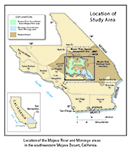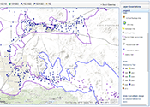Mojave Groundwater Resources
Mechanics of Land Subsidence
Land subsidence can occur in valleys containing aquifer systems that are, in part, made up of fine-grained sediments and that have undergone extensive ground-water development. The pore structure of a sedimentary aquifer system is supported by a combination of the granular skeleton of the aquifer system and the fluid pressure of the ground water that fills the intergranular pore space (Meinzer, 1928). When ground water is withdrawn in quantities that result in reduced pore-fluid pressures and water-level declines, more of the weight of the overlying sedimentary material must be supported by the skeleton. A loss of fluid-pressure support increases the intergranular load, or effective stress, on the skeleton. With a change in effective stress, the skeleton is subject to deformation—an increase in effective stress causes some degree of skeletal compression and a decrease causes expansion. The vertical component of this deformation sometimes results in irreversible compaction of the aquifer system and land subsidence. An aquifer-system skeleton that consists of primarily fine-grained sediments, such as silt and clay, is much more compressible than one that consists of primarily coarse-grained sediments, such as sand and gravel.
Aquifer-system deformation is elastic (recoverable) if the stress imposed on the skeleton is smaller than the previous maximum effective stress. The largest historical effective stress imposed on the aquifer system, sometimes the result of the lowest ground-water level, is called the "preconsolidation stress". When stresses are greater than the preconsolidation stress, the pore structure (granular framework) of the fine-grained sediments undergoes rearrangement toward a configuration that is more stable at higher stresses. This rearrangement results in an irreversible reduction of pore volume and, thus, in inelastic compaction of the aquifer system. Deformation under stresses in excess of the preconsolidation stress is 20 to more than 100 times greater than deformation under stresses less than the preconsolidation stress (Riley, 1998).
For an aquifer-system skeleton that has an appreciable thickness of fine-grained sediments, or confining layers, a significant part of the total compaction may be residual compaction (compaction that occurs in the confining layers while hydraulic heads in those layers equilibrate with hydraulic heads in the adjacent aquifers). Depending on the thickness and the vertical hydraulic diffusivity of a confining layer, fluid-pressure equilibration—and thus compaction—lags behind hydraulic head declines in the adjacent aquifers; this lag results in concomitant compaction that may require decades or centuries to approach completion. The time required to attain about 93 percent of the total compaction after water levels have stabilized is referred to as the time constant (Riley, 1969). Ireland and others (1984) estimated that the time constants for aquifer systems at 15 sites in the San Joaquin Valley ranged from 5 to 1,350 years. Terzaghi (1925) described this delay in his theory of hydrodynamic consolidation. Numerical modeling based on Terzaghi's theory has successfully simulated complex histories of compaction caused by known water-level fluctuations (Helm, 1978; Hanson, 1989; Sneed and Galloway, 2000). For a more complete description of aquifer-system compaction, see Poland (1984), and for a review and selected case studies of land subsidence caused by aquifer-system compaction in the United States, see Galloway and others (1999).
Mojave Region Maps
General Location

Detailed Location Map

Interactive Data Map

Well-Numbering System


To view PDF documents, you must have Adobe Reader installed on your computer.
